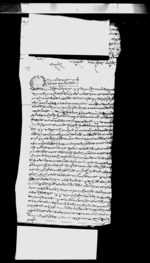A letter from Patan Potā Tahasila to the Guṭhī Bandobasta re settling questions of priestly authority over temples in the Patan Darbar area (VS 1964)
ID: K_0355_0066
Edited by
Ramhari Timalsina
Created: 2019-11-15;
Last modified: 2021-12-13
For the metadata of the document, click here
The accompanying edition, translation/synopsis and/or commentary are available under the terms of the Creative Commons Attribution-ShareAlike 4.0 International License
Abstract
This is a letter from the Patan Potā Tahasila to the Guṭhī Bandobasta Aḍḍā regarding emoluments for Sahadatta Miśra, who claims the priestly charge of Kṛṣṇa, Umāmaheśvara and Hariśaṅkara temples in Patan. He and Kamalākānta Upādhyāya both lay claim that post at the Umāmaheśvara temple.Diplomatic edition
[1r]
1⟪252⟫1श्री५सरकार2१1श्रीकृष्णजि
2२1श्रीउमामहेश्वर
2३1श्रीहरीसंकर
2४[Seal of the Patan Potā Tahasila]1पाटंपोतातहसिलअडावाट¯ ¯१¯तर्फ
2
3उप्रान्त•मैले•पुजागरेको•पाटंदरवारका•¯ ¯२¯३¯ ¯ कोपुजागरेको•५८सालदेषि•६३सालतक
4को•पुजाषर्चरपुजाहारी•षान्गी•षापेरदिनुभंन्या•पाटंपोता•अडाकानाउमाप्रमान्गीपाउन्या
5पुजाहारी•सहदत्तमिश्रले•चढाय़ाको•विन्तीपत्रमा•य़स्कोउजुरस्मेत•वुझीजाहेरगर्नु
6भंन्या•प्रमान्गीभय़ाकोछभनिविन्तीपत्रयसअडामातोकीपठाय़ाकोमा•सोपाटंदरवार
7कादेवताकोपुजाषर्चर•पुजाहारी•षान्गीदिनुभंन्या•तेसअडाकानाउमा•सनदभय़ाकोमा•निज
8सहदत्त•मिश्रले¯ ¯ ¯कोपुजागरेकोहोहोइन•कुनदेवताकोपुजागरेकोछदेवतास्मेत्
9वुझीसहिछापगरीपठाईदिनुभंन्यातेसअडावाटलेषिपठायाकालाई•पाटंचोकवजार
10कोपसलकोवाल५८सालदेषिलगतकसी•असुलतहसिलगरी•¯ ¯२¯३¯ ¯को५८सालदेषि
11दिनुपर्न्यारहेछभन्याऐनसव़ालको•रीतपुर्याई•दिनुभंन्या•येसअडा•कानाउमा•सनदभया
12कोर•¯ ¯२¯३¯ ¯ कानित्यपुजागरीषानपाउभनि•५४सालमासर्कारमाथिविन्तिचढाय़ाकोवमो
13जिम•मेरानाउमादरीपुजाषर्चरपुजाहारीषान्गीषाईआयाकोठियो•यो५८सालको
14षान्गी•पुजाषर्चस्मेत•गुठीवन्दोवस्तअडामालिनजादा•अवहाञाँवाटदिनेहोइनपाटंपो
15ताअडामर्फतदिनेभय़ो•निजअडामालीनजानुभनि•गुठीवन्दोवस्तअडावाटभनेव़मो
16जिम•पाटंपोता•अडामा•लिनजादा•दिनुभंन्या•सनदनभै•दिंन•भनि•५८सालदेषि
17पुजाषर्चदिये़न•जाहावाटदिनेहो•दिलाईदिनुभंन्या•गुठीवन्दोवस्तकानाउमा•प्रमान्[...]
18गरीपाउभनि•निज•पुजाहारीसहदत्तले•विन्तीपत्रचढाय़ाकोमा•येसलेपाउनेजे
19होदिनुभंन्या•येसअडामाप्रमान्गीस्मेत•विन्तीपत्रआय़ाकोहुनालेनिजसहदत्तलेकुं
20कुंदेवतापुजागरिआयाकोछभनि•तेसगुठीवन्दोवस्तअडालाई•लेषोट्गरेकोमा६१
21साल•कोगुठीगुठीकोकामदाररकमी•हरूको•षान्गीवाली•दिनुपर्ने•भनिसाविक•वाट
22षरीदार•गुणराज•पाध्याले•लेषिदियाकोषान्गी•वालीको•लागतमा•¯ ¯४¯ कापुजा
23रीसहदत्त•मिश्रकेमोहरु१०भनिलेषियाकोछ¯ ¯३¯कोदिनुपर्ने•भंन्यारसो
24सालदेषिअघिकोदिनुपर्नेभंन्यासमेत•लेषियाकोछैन•भंन्यातेसअडावाटपुर्जिका
25पिठमाजवाफलेखिपठायाकोर•तेसअडामाचुमाव़नतिरेकारसिद•स्मेत•येसअडामा
26दाषिलागरेकोमावुझ्दा•¯ ¯२¯४¯ ¯ कापुजाहारी•भंन्या•लेषियाकोर•निजसहदत्तले•¯ ¯४¯
27को•पुजागरिनआयाको•¯ ¯३¯कादेव़ालयमाभन्ये•निजले•५४साल•देषिपुजागरि
28षाइआय़ाको•भंन्या•विन्तीपत्रमालेषियाकोरपाटनसोठतोलको•कमलाकान्तदे
29उभाजुलेपनि•अघिपुर्षाकापालादेषि•पुजागरिआय़ाकोनिजसहदत्तलेपुजाषर्च
30पाउनुपर्नेहोइन•भंन्याविन्तीपत्रचढायामा•भयाकाप्रमान्गीव़मोजिमदुवैजना
31को•सरजमीनवुझीरहेकोछ•इतिसम्व़त्•१९६४साल•श्रावण•गते२०रोज१
32शुभम्•¯¯¯¯¯¯¯¯¯¯¯¯¯¯¯¯¯¯
Synopsis
This letter, relating to the priestly charge of Kṛṣṇa, Umāmaheśvara and Hariśaṅkara temples of Patan Palace, was sent from the PatanPotā Tahasila to the Guṭhī Bandobasta Aḍḍā on Sunday, the 20th day of Śrāvaṇa in the Vikrama era year 1964. In VS 1954 Sahadatta Miśra of Mahāpāla Ṭola in Patan petitioned the government to be entrusted with the priestly duties of the Kṛṣṇa and Umāmaheśvara temples at Patan Palace, and since then had been enjoying the emolument for performing daily worship in the temples. In VS 1958, when he went to the Aḍḍā to collect his emolument, he was told that the office was no longer responsible for providing it; instead he should go to Patan’s Potā Tahasila. There, however, he was told that the emolument could not be provided to him without a sanada from the authorities. Later he submitted a petition, probably to Prime Minister Candra Śamśera, claiming the worship expenses and emolument for his service at the temples from VS 1958 to 1963. An authorization (pramāṅgī) was issued to the Patan Potā Tahasila to provide him with what he was eligible for, and a document conveying the emolument (sanada) to the Guṭhī Bandobasta Aḍḍā. In a descriptive list prepared by kharadāraGuṇarāja Pādhyā in 1961, Miśra had been mentioned as the priest of the Hariśaṅkara temple. On the other hand, Kamalākānta Deubhāju of Soṭha Tola in Patan was also claiming to be the legitimate priest of the Umāmaheśvara temple. A preliminary inquiry made by the Patan Potā Tahasila disclosed that Miśra was not the legitimate priest of the Hariśaṅkara temple. At the end of the letter, the Patan Potā Tahasila reports to the Guṭhī Bandobasta Aḍḍā that the claims of both litigants were still being investigated.
Commentary
A related document, K_0355_0060, mentions that a sindurajātrā (a procession showering vermilion powder) took place in Patan (sometime between 5 March 1901 and 27 June 1901) in honour of Deva Śamśera, and on that occasion he announced that the palace would appoint priests for ritual worship in the temples where daily worship was not being performed. According to Miśra's competitor Kamalākānta, Miśra started to perform the temple worship after the announcement, with the intention of forcefully obtaining the priestly emolument of the Umāmaheśvara temple. Kṛṣṇacandra Jhā of Cīkaṃmugala Ṭola by contrast presented a petition to the prime minister (see K_0355_0063) to be granted the priest’s post at the Viṣṇu, Umāmaheśvara and Cyāsilīṃ Devala Kṛṣṇa temples of Patan.
There are a number of similarly named temples in Patan, which creates difficulties in identifying the temple referred in the document. However, a related document, K_0355_0060, specifies the Umāmaheśvara temple as a ḍhuṅgā devala (i.e., a temple made of stone) located near the Patan Palace. Still another document, K_0355_0063, specifies that the temple is one of six temples in the area, while the present document, too, notes that the temples are from the Patan Palace area. Therefore, it is obvious that the Kṛṣṇa temple mentioned in this document must be the one identified as LAL1240 in DANAM (see, https://nhdp-test.kjc.uni-heidelberg.de/resource/74ae042c-e6a8-11e9-b125-0242ac130002). Similarly, the Umāmaheśvara temple must be LAL1190 (see, https://nhdp-test.kjc.uni-heidelberg.de/report/34d6f310-e5e3-11e9-8bc4-0242ac130002) and the Hariśaṅkara temple must be LAL1280 (see, https://nhdp-test.kjc.uni-heidelberg.de/report/256339d6-e9d3-11e9-8bc4-0242ac130002).

